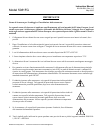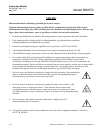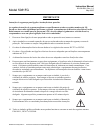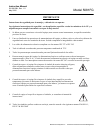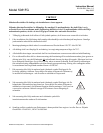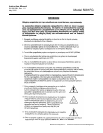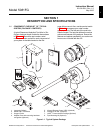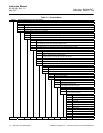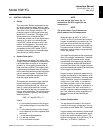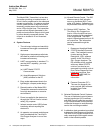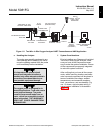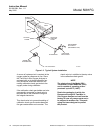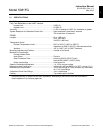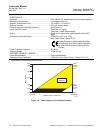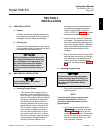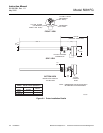
Instruction Manual
IB-106-5081, Rev. 1.0
May 2005
Rosemount Analytical Inc. A Division of Emerson Process Management Description and Specifications 1-3
Model 5081FG
1-2 SYSTEM OVERVIEW
a. Scope
This Instruction Bulletin is designed to sup-
ply details needed to install, start up, oper-
ate, and maintain the Rosemount Analytical
Two-Wire In Situ Oxygen Analyzer. The
analyzer consists of an oxygen probe and
Model 5081 Transmitter. The signal condi-
tioning electronics of the Model 5081
Transmitter outputs a 4-20 mA signal repre-
senting an O
2
value. An infrared remote
control (IRC) allows access to setup, cali-
bration, and diagnostics. This same infor-
mation, plus additional details, can be
accessed with the HART Model 275/375
handheld communicator or Asset Manage-
ment Solutions (AMS) software.
b. System Description
The Rosemount Analytical Two-Wire In Situ
Oxygen Analyzer is designed to measure the
net concentration of oxygen in an industrial
process; i.e., the oxygen remaining after all
fuels have been oxidized. The oxygen probe
is permanently positioned within an exhaust
duct or stack and performs its task without the
use of a sampling system. The Model 5081
Transmitter is mounted remotely and condi-
tions the oxygen probe outputs.
The equipment measures oxygen percent-
age by reading the voltage developed
across an electrochemical cell, which con-
sists of a small yttria-stabilized, zirconia
disc. Both sides of the disc are coated with
porous metal electrodes. The millivolt output
voltage of the cell is given by the following
Nernst equation:
EMF = KT log10(P1/P2) + C
Where:
1. P
2
is the partial pressure of the oxygen
in the measured gas on one side of the
cell.
2. P
1
is the partial pressure of the oxygen
in the reference air on the opposite side
of the cell.
3. T is the absolute temperature.
4. C is the cell constant.
5. K is an arithmetic constant.
NOTE
For best results, use clean, dry, in-
strument air (20.95% oxygen) as the
reference air.
NOTE
The probe uses a Type B thermocou-
ple to measure the cell temperature.
When the cell is at 550°C to 1600°C
(1022°F to 2912°F) and there are unequal
oxygen concentrations across the cell, oxy-
gen ions will travel from the high oxygen
partial pressure side to the low oxygen par-
tial pressure side of the cell. The resulting
logarithmic output voltage is approximately
50 mV per decade.
The output is proportional to the inverse loga-
rithm of the oxygen concentration. Therefore,
the output signal increases as the oxygen
concentration of the sample gas decreases.
This characteristic enables the Rosemount
Analytical Two-Wire In Situ Oxygen Analyzer
to provide exceptional sensitivity and accuracy
at low oxygen concentrations.
Oxygen analyzer equipment measures net
oxygen concentration in the presence of all
the products of combustion, including water
vapor. Therefore, it may be considered an
analysis on a "wet" basis. In comparison
with older methods, such as the portable
apparatus, which provides an analysis on a
"dry" gas basis, the "wet" analysis will, in
general, indicate a lower percentage of oxy-
gen. The difference will be proportional to
the water content of the sampled gas
stream.
c. System Configuration
The equipment discussed in this manual
consists of two major components: the oxy-
gen probe and the Model 5081 Transmitter.
Oxygen probes are available in three length
options, providing in situ penetration appro-
priate to the size of the stack or duct. The
options on length are 20 in. (508 mm), 26 in.
(660 mm), or 34.625 in. (880 mm).
1



